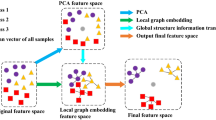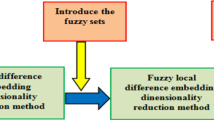Abstract
In graph-based linear dimensionality reduction algorithms, it is crucial to construct a neighbor graph that can correctly reflect the relationship between samples. This paper presents an improved algorithm called fuzzy local maximal marginal embedding (FLMME) for linear dimensionality reduction. Significantly differing from the existing graph-based algorithms is that two novel fuzzy gradual graphs are constructed in FLMME, which help to pull the near neighbor samples in same class nearer and nearer and repel the far neighbor samples of margin between different classes farther and farther when they are projected to feature subspace. Through the fuzzy gradual graphs, FLMME algorithm has lower sensitivities to the sample variations caused by varying illumination, expression, viewing conditions and shapes. The proposed FLMME algorithm is evaluated through experiments by using the WINE database, the Yale and ORL face image databases and the USPS handwriting digital databases. The results show that the FLMME outperforms PCA, LDA, LPP and local maximal marginal embedding.








Similar content being viewed by others
References
Batur A, Hayes M (2001) Linear subspaces for illumination robust face recognition. Proc IEEE Int Conf Comput Vis Pattern Recogn 2(1):296–301
Belhumeur PN, Hespanda JP, Kiregeman DJ (2007) Eigenfaces versus Fisherfaces: recognition using class specific linear projection. IEEE Trans Pattern Anal Mach Intell 19(7):711–720
Belkin M, Niyogi P (2003) Laplacian eigenmaps for dimensionality reduction and data representation. Neural Comput 15:1373–1396
Fukunnaga K (1991) Introduction to statistical pattern recognition, 2nd edn. Academic Press, London
He X, Niyogi P (2003) Locality preserving projections. In: Proceedings of the 16th conference on neural information processing systems
He X, Yan S, Hu Y, Niyogi P, Zhang H (2005) Face recognition using Laplacianfaces. IEEE Trans Pattern Anal Mach Intell 27(3):328–340
Jain AK, Duin RPW, Mao J (2000) Statistical pattern recognition: a review. IEEE Trans Pattern Anal Mach Intell 22(1):4–37
Keller JM, Gray MR, Givens JR (1985) A fuzzy k-nearest neighbor algorithm. IEEE Trans Syst Man Cybernet 15(4):580–585
Kokiopoulou E, Saad Y (2009) Enhanced graph-based dimensionality reduction with repulsion Laplaceans. Pattern Recogn 42(11):2392–2402
Kwak KC, Pedrycz W (2005) Face recognition using a fuzzy Fisherface classifier. Pattern Recogn 38:1717–1732
Laskaris NA, Zafeiriou SP (2008) Beyond FCM: graph-theoretic post-processing algorithms for learning and representing the data structure. Pattern Recogn 41(8):2630–2644
Martinez AM, Kak AC (2001) PCA versus LDA. IEEE Trans Pattern Anal Mach Intell 23(2):228–233
Roweis ST, Saul LK (2000) Nonlinear dimensionality reduction by locally linear embedding. Science 290:2323–2326
Tenenbaum JB, Desilva V, Langford JC (2000) A global geometric framework for nonlinear dimensionality reduction. Science 290:2319–2323
Turk M, Pentland A (1991) Face recognition using eigenfaces. In: Proceedings of the IEEE conference on computer vision and pattern recognition, pp 586–591
Zhao C, Lai Z, Sui Y, Chen Y (2008) Local maximal marginal embedding with application to face recognition. Proc 2nd Chin Conf Pattern Recogn 1(1):215–220
Yang J, Zhang D, Yang JY (2007) Globally maximizing, locally minimizing: unsupervised discriminant projection with applications to face and palm biometrics. IEEE Trans Pattern Anal Mach Intell 29(4):650–664
Ye J, Janardan R, Park C, Park H (2004) An optimization criterion for generalized discriminant analysis on under-sampled problems. IEEE Trans Pattern Anal Mach Intell 26(8):982–994
Yu H, Yang J (2001) A direct LDA algorithm for high dimensional data-with application to face recognition. Pattern Recogn 34(10):2067–2070
Acknowledgments
This work is partially supported by the Fujian Provincial Department of Science and Technology of China under grant no. JK2010046, JB10135, JA10226, 2009I0020. It is also partially supported by the National Science Foundation of China under grant no. 60472061, 60632050, 90820004 and Hi-Tech Research and Development Program of China under grant no. 2006AA04Z238. It is also partially supported by the Ministry of Industry and Information Technology of china under grant no. E0310/1112/JC01.
Author information
Authors and Affiliations
Corresponding author
Rights and permissions
About this article
Cite this article
Zhao, C., Lai, Z., Liu, C. et al. Fuzzy local maximal marginal embedding for feature extraction. Soft Comput 16, 77–87 (2012). https://doi.org/10.1007/s00500-011-0735-y
Published:
Issue Date:
DOI: https://doi.org/10.1007/s00500-011-0735-y




